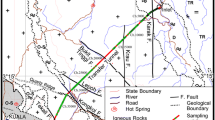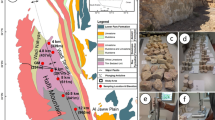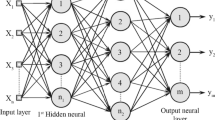Abstract
Uniaxial compressive strength is one of the most important mechanical characteristics of rocks, and its prediction is essential in most rock engineering projects. Recently, several types of research have been conducted regarding the relationship between the petrophysical and geomechanical properties of rocks and geophysical parameters, among which geoelectric and seismic methods have been the most utilized and efficient. In this research, the prediction of uniaxial compressive strength (UCS) has been investigated utilizing the geoelectrical method. In the present study, after sampling from the studied area, the core samples were saturated and by installing special electrodes, the changes in electrical resistivity during compressive stress loading were measured and monitored in the laboratory environment. Laboratory samples with various structures and textures indicated different electrical behaviors during the application of compressive stress which stresses the significant effect of the volume proportion of aggregates on petrophysical and geomechanical properties. In core samples prepared from fault breccias and alluvial materials with a volumetric block proportion (VBP) of 25–75%, a significant correlation was observed between the UCS and the measured electrical resistivity values. The neuro-fuzzy model presented with a decision factor (R2) of 99.7%, root sum of square error (RMSE) of 2.511, geometric mean error ratio (GMER) of 0.865, and relative improvement index (RI) of 71.08 can predict uniaxial compressive strength (UCS) more accurately than artificial neural network and multivariable regression methods.
























Similar content being viewed by others
Data availability
The authors confirm that the data supporting the findings of this study are available within the article and its supplementary materials.
References
Alzabeebee S, Jamei M, Hasanipanah M, Bakhshandeh H, Karbasi M, Keawsawsvong S (2022b) Development of a new explicit soft computing model to predict the blast-induced ground vibration. Geomech Eng 30(6):551–564
Alzabeebee S, Mohammed DA, Alshkane YM (2022a) Experimental study and soft computing modeling of the unconfined compressive strength of limestone rocks considering dry and saturation conditions. Rock Mech Rock Eng
Ara T, Bjorndalen N, Talabani S, Islam R (2004) Predicting oil reserve in carbonate reservoirs. EEC Innov 2:20–43
Archie GE (1942) The electrical resistivity log as an aid in determining some reservoir characteristics. Trans Am Inst Min Metall Pet Eng 146:54–62
Asem P (2020) Prediction of unconfined compressive strength and deformation modulus of weak argillaceous rocks based on the standard penetration test. Int J Rock Mech Min Sci 133:104397
ASTM (1997) Standard test method for uniaxial compressive strength of intact core specimens, ASTM Annual Book of Standards, D2938-95: 279-281
Bai G, Sun Q, Geng J, Wang S, Jing X (2022) Resistivity of granite and sandstone varies with frequency and water saturation. Geomech Geophys Geo-Energy Geo-Resour 8(6)
Cemiloglu A, Zhu L, Arslan S, Xu J, Yuan X, Azarafza M, Derakhshani R (2023) Support vector machine (SVM) application for uniaxial compression strength (UCS) prediction: a case study for Maragheh limestone. Appl Sci 13(4):2217
Cockx L, Meirvenne M, Vitharana U, Van Coillie F, Verbeke L, Simpson D, Saey T, Viscarra Rossel R, Mcbratney A, Minasny B (2010) A neural network approach to topsoil clay prediction using an EMI-based soil sensor. In book: Proximal Soil Sensing, Chapter 20
Cohen J, Cohen P, West SG, Aiken LS (2003) Applied multiple regression/correlation analysis for the behavioral sciences, 3rd edn. Lawrence Erlbaum, Mahwah, NJ
Dong Z, Sun Q, Zhang W (2022) Prediction of strength of rock after thermal treatment through dielectric property. Q J Eng Geol Hydrogeol 55(4)
Ghorbani A, Cosenza P, Revil A, Zamora M, Schmutz M, Florsch N, Jougnot D (2009) Non-invasive monitoring of water content and textural changes in clay-rocks using spectral induced polarization: a laboratory investigation. Appl Clay Sci 43:493–502
Ghorbani A, Ali Ghari H, Namiranian A (2012) Electrical resistivity monitoring of rock samples during uniaxial compression test. Iran J Geophys 6(1):34–41
Glover PWJ, Gomez JB, Meredith PG (2000) Fracturing in saturated rocks undergoing triaxial deformation using complex electrical conductivity measurements; experimental study. Earth Planet Sci Lett 5621:201–213
Gujarati DN (2004) Multiple regression analysis: the problem of inference. Basic Econometrics, Chapter 8:26
Ince I (2022) Predicting index-mechanical properties of igneous rock using electrical resistivity method. Min Metal Explor 39(5)
Inoue M, Ohomi M (1989) Relation between uniaxial compressive strength and elastic wave velocity of soft rock. Proceedings of the International Symposium on Weak Rock, Tokyo, pp 9–13
Kahraman S (2001) Evaluation of simple methods for assessing the uniaxial compressive strength of rock. Int J Rock Mech Min Sci 38:981–994
Kahraman S (2022) Estimating the physico-mechanical properties of pyroclastic rocks from electrical resistivity. Pure Appl Geophys 179:1–9
Kahraman S, Alber M (2014) Electrical impedance spectroscopy measurements to estimate the uniaxial compressive strength of a fault breccia. Bull Mater Sci 37(6):1543–1550
Kahraman S, Albert M (2006) Predicting the physico-mechanical properties of rocks from electrical impedance spectroscopy measurement. Int J Rock Mech Min Sci 43:543–553
Kate JM, Gokhale CS (1998) Electrical resistivity behaviour of sandstone during compression. In: Moore DP, Hungr O (eds) Proceedings of the eighth International Congress IAEG, vol 1. Balkema, Rotterdam, pp 543–550
Kate JM, Rao KS (1989) Effect of large overburden stress on geophysical behaviour of sandstones. In: Maury V, Fourmaintraux D (eds) Proceedings of the ISRM-SPE International symposium on rock at great depth. Balkema, Rotterdam, pp 171–178
Kate JM, Sthapak AK (1995) Engineering behaviour of certain Himalayan rocks. In: Daemen JJK, Schultz RA (eds) Proceedings of the 35th US symposium on rock mechanics. Balkema, Rotterdam, pp 783–788
Leskovec J, Rajaraman A, Ullman JD (2014) Mining of massive datasets, Chapter 9, p 329
McNally GH (1987) Estimation of coal measures rock strength using sonic and neutron logs. Geo-exploration 24:381–395
Medley EW (2004) Observations on Tortuous Failure Surfaces in Bimrocks. J Eng Geol Geomech Tunneling 22:35–43
Mohammadian R, Hajizadeh F, Moomivand H (2018) The incorporation of geoelecterical and geomechanical data to explore water conveyance tunnel route (case study), vol 128. Master of Science Thesis, Urmia University
Qiu J, Yin X, Pan Y, Wang X, Zhang M (2022) Prediction of uniaxial compressive strength in rocks based on extreme learning machine improved with metaheuristic algorithm. Mathematics 10(19):3490
Pearson K (1901) On lines and planes of closest fit to systems of points in space. Philos Mag Ser 6 2(11):559–572
Ranjbar S, Karimi Nasab S (2019) Determination of uniaxial compressive strength of granite rock samples using electrical resistivity measurement: NDT. 10
Schon JH (1998) Physical properties of rocks, fundamentals and principles of petrophysics. Pergamon, Oxford, p 583
Sharma PK, Singh TN (2008) A correlation between P-wave velocity, impact strength index, slake durability index and uniaxial compressive strength. Bull Eng Geol Environ 67:17–22
Sousa LMO, Suárez del Río LM, Calleja L, Ruiz de Argandoña VG, Rey AR (2005) Influence of microfractures and porosity on the physico-mechanical properties and weathering of ornamental granite. Eng Geol 77:153–168
Taghavi B, Hajizadeh F, Abbasi M (2015) Exploration of water transfer tunnel route based on geoelectrical, geomechanical and telemetry data using neural networks (with case study). Urmia University, p 143 (Master of Science Thesis)
Taghavi B, Hajizadeh F, Abbasi M (2017) Geoelectrical imaging surveys used for pre-investigation and subsurface layers modeling at a water transfer tunnel (case study). J Eng Appl Sci 12(8):8409–8416
Turgrul A, Zarif I (1999) Correlation of mineralogical and textural characteristics with engineering properties of selected granitic rocks from turkey. Eng Geol 51:303–317
Wang M, Wan W, Zhao Y (2020) Prediction of the uniaxial compressive strength of rocks from simple index tests using a random forest predictive model. CR Mec 348(1):3–32
Yasar E, Erdogan Y (2004) Correlating sound velocity with the density, compressive strength and Young’s modulus of carbonate rocks. Int J Rock Mech Min Sci 41:871–875
Yusuf Hassan M, Arman H (2022) Several machine learning techniques comparison for the prediction of the uniaxial compressive strength of carbonate rocks. Sci Rep 12(1):20969
Zhao R, Shi S, Li S, Guo W, Zhang T, Li X, Lu J (2023) Deep learning for intelligent prediction of rock strength by adopting measurement while drilling data. Int J Geomech Arch 23(4)
Author information
Authors and Affiliations
Contributions
All authors contributed to the study conception and design. Material preparation, data collection, and analysis were performed by Behnam Taghavi, Farnusch Hajizadeh, and Hassan moomivand. The first draft of the manuscript was written by Behnam Taghavi, and all authors commented on previous versions of the manuscript. All authors read and approved the final manuscript.
Corresponding author
Ethics declarations
Competing interests
The authors declare that they have no competing interests.
Rights and permissions
Springer Nature or its licensor (e.g. a society or other partner) holds exclusive rights to this article under a publishing agreement with the author(s) or other rightsholder(s); author self-archiving of the accepted manuscript version of this article is solely governed by the terms of such publishing agreement and applicable law.
About this article
Cite this article
Taghavi, B., Hajizadeh, F. & Moomivand, H. Comparison of artificial intelligence and multivariate regression methods in predicting the uniaxial compressive strength of rock during the specific resistivity monitoring. Bull Eng Geol Environ 82, 409 (2023). https://doi.org/10.1007/s10064-023-03415-w
Received:
Accepted:
Published:
DOI: https://doi.org/10.1007/s10064-023-03415-w




